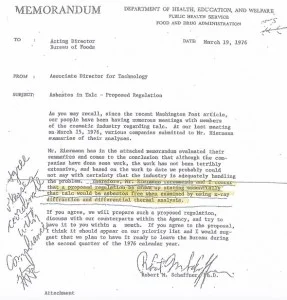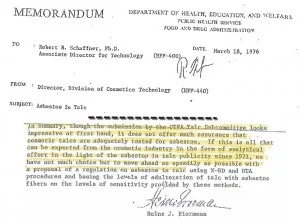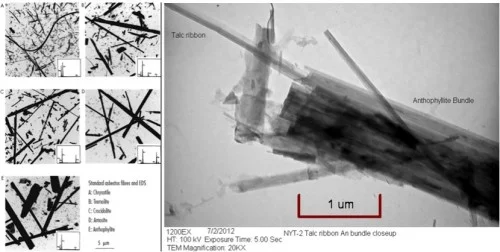|
|
Last
Modified on
Jul 29, 2025
Recent health and safety information has arisen with regard to asbestos contamination of common talc baby powder products, including talc products sold by Johnson Johnson, and other talcum powder products still for sale throughout the United States.
During 2016 and 2017, defective product personal injury litigation has given rise to allegations that Johnson Johnson, and other companies, have continued to sell talcum baby powder for decades adulterated by some percentage of asbestos or adulterated by what is called “asbestiform talc” (i.e. a form of talc fibers highly similar in chemical composition to asbestos fibers). Additionally, pathology studies conducted on cancerous ovary tissue, in recent ovarian cancer/talc personal injury litigation, has confirmed the presence of both talc and asbestos fibers in some tissue samples studied by specialists.
In a deposition from December 2016, one chemist described having done testing in the 1970’s of various Johnson Johnson baby powder products and having microscopically confirmed asbestos adulterating the baby powder in about 50 percent of the baby powder bottles that he tested. This was at a time that the FDA was considering regulating cosmetic talc products but J J and other consumer products companies selling cosmetic powders with talc assured the FDA that it had refined its mining methods to eliminate asbestos, and, in the end, the FDA never regulated the cosmetic talc powder products for asbestos in the United States. In other words, consumers since the 70s, buying talcum powder products, had to trust these companies not to be selling a product adulterated by asbestos. Keep in mind, asbestos was the first well known carcinogen regulated by OSHA because it is known to cause terminal mesothelioma cancers, as well as cancers to numerous tissues of the human body.
Un gran número de abogados están llevando a cabo casos en todo Estados Unidos alegando no sólo que los cánceres de ovario están causados por las fibras de talco en los productos de polvos de talco para bebés, sino que se están presentando nuevas demandas alegando que muchos productos de polvos de talco siguen contaminados con amianto. También se han presentado algunas demandas alegando que el mesotelioma pleural, los mesoteliomas peritoneales y varios otros tipos de cáncer no sólo están relacionados con los productos de talco para bebés, sino que pueden haber sido causados por la adulteración de las fibras de amianto o talco asbestiforme contenidas en estos productos de talco para bebés de consumo común.
Johnson and Johnson, the leading retailer of talc baby powder, has steadfastly refused to put any warning on their talc baby powder products, whether the warnings advise of higher rates of cancer in general, of potential adulteration with asbestos, or even that talc has been associated with higher rates of ovarian cancers. After hearing the evidence in a number of court cases, juries have sided with the women suffering ovarian cancers in the majority of the trials over the last year. Juror interviews during 2017 indicated that many were appalled that J J resisted placing any warnings on the talc baby powder products, based on the totality of the evidence.
Volvamos a los años 70
The government was seriously considering regulating talc in cosmetic powders since there was solid evidence asbestos was in these products. The industry needed to tamp down the call for regulations and had to convince regulators that they would remove all the adulteration with asbestos. But how? The talc industry decided to provide the regulators with testing that they conducted (without direct government oversight) to show virtually no asbestos was in their current baby powder talc products. Just how serious were the regulators in the 70s? Read the two memos below, shown in pertinent excerpts:


Caption: FDA 1976 memos.
Yes, the FDA was ready to regulate but then the talc industry, including J J, Colgate, Chesebrough-Ponds, and others, provided various tests by private consultants, to show that the asbestos adulteration was virtually nil or zero.
Entonces apareció un denunciante
Why do whistleblowers step forward? What motivates them? Is it simply the desire to reveal the truth? What if there is no compensation? A whistleblower came forward n December 2016 in one of the pending J J ovarian cancer baby powder cases pending in St. Louis, Missouri. He was working on his Ph.D. under a then-noted chemist who was hired by the talc industry to test their products in the 1970s. This young chemist, Aviam Elkies planned to study under the New York chemist, Dr. Lewin, and his role was to test the J J baby powder products for the presence of asbestos fibers.
Elkies never finished his Ph.D. under Dr. Lewin when the study funding was cancelled by J J. He later moved to Israel where he taught chemistry for many years, but he never forgot what happened when he worked on this aborted project. When he heard about allegations of asbestos in J J talcum baby powder in the international press, he contacted one of the plaintiff’s lawyers mentioned in the news article.
Rodeado de abogados demandantes de responsabilidad por productos defectuosos y de abogados de minas de talco y minoristas de polvos de talco para bebés, prestó el 15 de diciembre de 2016 el testimonio jurado que se extracta a continuación.
Testimonio de AVIAM ELKIES
A: At the moment, I live in Israel.Q: Okay. What city in Israel?
A: Herzliya (fonético).
P: Y, Sr. Elkies, ¿ha... ha vivido alguna vez en los Estados Unidos
R: Sí. Viví 10 años entre 1970 y 1980.
P: De acuerdo.
R: Viví diez años en Nueva York.
P:Antes de vivir en Nueva York durante unos 10 años... bueno, volvamos atrás. ¿Dónde nació?
R: En Israel.
P: ¿Y en qué año fue eso? No quiero envejecerle.
A: 1944. I did my first degree in Israel, bachelor of science in chemistry. When I came to America, I made my master’s degree at CUNY University of New York. Then I wanted to do my Ph.D., and I was enrolled and registered and worked at NYU. And over there, it was the end of that, because I didn’t get my degree.
P: Bien. ¿No obtuvo el doctorado?
R: Así es.
P: ¿Así que aproximadamente en 1980 regresó a Israel?
R: Israel. Así es.
Q: Do you know how many — approximately the total number of samples that Johnson Johnson sent you of talc to be tested?
R: No me acuerdo. Fueron docenas, pero no me acuerdo.
Q: Could you say what percentage of the samples, of the total number that you were testing for Johnson Johnson’s, found asbestos?
R: Más del 50%.
P: ¿Se completó alguna vez este estudio?
R: No.
P: Y dígale al jurado por qué.
R: Un día el profesor Lewin me dijo que quería toda la documentación para comprobarla. Y después de que él tomó todo el papeleo, los pocos días más tarde, me dijo
that the scholarship was stopped by Johnson Johnson and there was no more.
P: ¿Se completó alguna vez el estudio?
R: No, no estaba terminado, porque un día el profesor Lewin me dijo: "Déjame ver todos los papeles que has recogido". Se llevó los papeles. Y unos días después, me dijo que la beca se había suspendido y que no había más investigación.
Q: To your knowledge, were the findings that you initially found regarding this Johnson Johnson scholarship ever published?
R: Por lo que yo sé, no. Porque si lo hubiera sido, mi nombre debería haber estado en él.
P: ¿Cómo has llegado hasta mí?
R: Un día leí en el periódico que había un caso contra una mujer en algún lugar de Estados Unidos, no recuerdo el lugar, y que había ganado el caso por cáncer en los ovarios, en sus ovarios, a causa del amianto. Busqué en Google, y encontré al abogado Jim Onder, en algún lugar de Texas, si mal no recuerdo. Y lo llamé, y le digo, Mira, yo era un estudiante aquí y allá.
Hay cientos de páginas de testimonios adicionales en los que los abogados de la industria del talco intentaron desacreditar a este valiente denunciante. Pero la cuestión era irrefutable: la industria ocultó los estudios que demostraban la adulteración del amianto en los polvos de talco para bebés.
Los abogados de las mujeres que padecen cáncer de ovario o han fallecido a causa de él están estudiando si las fibras finas de talco causan por sí solas las tasas más elevadas de cáncer de ovario, o si la combinación de fibras de talco y amianto causa a la vez las tasas más elevadas de cáncer.
La estructura mineral del talco es similar a la del amianto
Because talc and asbestos are both silicates formed by similar geological conditions, they often form in similar geographical locations in the Earth. In the proper geological conditions, talc can (over millions of years) change into asbestos, and asbestos can change into talc. Viewed under a microscope, there are fibers also known as asbestiform talc, which chemists distinguish only by the microscopic width and length of the fibers. In the Earth, talc and asbestos are often mined near to each other, as they form in similar mine veins. Geologists and mineralogists have studied and known about the similarity in talc and asbestos for over a century. The microscopic structure of asbestos and talc is shown below.

Pie de foto: A la izquierda, diversas formas de fibras de amianto; a la derecha, una cinta de talco junto a un haz de amianto.
En un estudio Durante 2015, los científicos confirmaron que decenas y decenas de envases de polvos de talco Cashmere Bouquet estaban adulterados con amianto. The product had been sold for decades but Colgate sold off the brand in 1995. Why? Perhaps it was not a successful product, perhaps Colgate was concerned about asbestos adulteration liability. Colgate can still be held liable for an adulterated talc powder which was laced with asbestos when it sold the product, and indeed Colgate perdió en 2016 una demanda por mesotelioma interpuesta por una usuaria de polvos de talco durante mucho tiempo (este cáncer terminal tiene un periodo de latencia de 10 a 50 años).
¿El crimen del siglo o el fraude del siglo?
Imagine una película de suspense de Hollywood en la que el villano ha adulterado a sabiendas un producto de consumo muy común con carcinógenos venenosos conocidos por causar innumerables cánceres, y que estos horribles cánceres pueden surgir años o décadas después, causando decenas de miles de muertes.
Imaginemos que el villano adultera lo que se considera uno de los productos de consumo más seguros imaginables, que se ha vendido sin advertencias en Estados Unidos durante más de 100 años, siendo ese producto el talco para bebés.
Imaginemos entonces que en el último acto de la película se desenmascara al villano, y el público exige un castigo rápido y proporcionado para él.
Ahora imagine que el villano resulta ser una de las empresas de productos de consumo más fiables.
Would keeping this secret from the public and from government regulators be considered the crime of the century? Perhaps not, because it may or may not be a criminal act, but it could be a significant fraudulent act, a material concealment, a massive civil wrong tied to countless thousands of cancers and deaths stretching over decades.
Whether this alleged concealment by the talc industry is the fraud of the century will continue playing out in the state and federal civil courtrooms of the United States over months and years. Who knew what and when? Have thousands of women died for decades from (supposedly safe) talc baby powder? Stay tuned.












